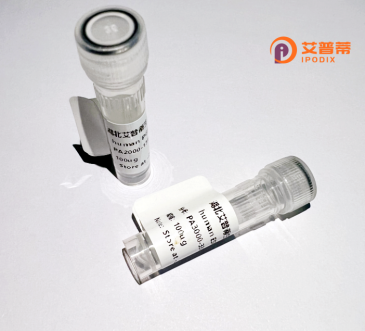
| 纯度 | >90%SDS-PAGE. |
| 种属 | Human |
| 靶点 | APS |
| Uniprot No | O14492 |
| 内毒素 | < 0.01EU/μg |
| 表达宿主 | E.coli |
| 表达区间 | 1-632aa |
| 氨基酸序列 | MNGAGPGPAA AAPVPVPVPV PDWRQFCELH AQAAAVDFAH KFCRFLRDNP AYDTPDAGAS FSRHFAANFL DVFGEEVRRV LVAGPTTRGA AVSAEAMEPE LADTSALKAA PYGHSRSSED VSTHAATKAR VRKGFSLRNM SLCVVDGVRD MWHRRASPEP DAAAAPRTAE PRDKWTRRLR LSRTLAAKVE LVDIQREGAL RFMVADDAAA GSGGSAQWQK CRLLLRRAVA EERFRLEFFV PPKASRPKVS IPLSAIIEVR TTMPLEMPEK DNTFVLKVEN GAEYILETID SLQKHSWVAD IQGCVDPGDS EEDTELSCTR GGCLASRVAS CSCELLTDAV DLPRPPETTA VGAVVTAPHS RGRDAVRESL IHVPLETFLQ TLESPGGSGS DSNNTGEQGA ETDPEAEPEL ELSDYPWFHG TLSRVKAAQL VLAGGPRNHG LFVIRQSETR PGEYVLTFNF QGKAKHLRLS LNGHGQCHVQ HLWFQSVLDM LRHFHTHPIP LESGGSADIT LRSYVRAQDP PPEPGPTPPA APASPACWSD SPGQHYFSSL AAAACPPASP SDAAGASSSS ASSSSAASGP APPRPVEGQL SARSRSNSAE RLLEAVAATA AEEPPEAAPG RARAVENQYS FY |
| 分子量 | 67.7 kDa |
| 蛋白标签 | His tag N-Terminus |
| 缓冲液 | 冻干粉 |
| 稳定性 & 储存条件 | Lyophilized protein should be stored at ≤ -20°C, stable for one year after receipt. Reconstituted protein solution can be stored at 2-8°C for 2-7 days. Aliquots of reconstituted samples are stable at ≤ -20°C for 3 months. |
| 复溶 | Always centrifuge tubes before opening.Do not mix by vortex or pipetting. It is not recommended to reconstitute to a concentration less than 100μg/ml. Dissolve the lyophilized protein in distilled water. Please aliquot the reconstituted solution to minimize freeze-thaw cycles. |
以下是3篇关于重组人APS蛋白的参考文献概览:
---
1. **文献名称**:*Cloning, expression, and purification of human APS protein for structural studies*
**作者**:Liu Y, Rui L
**摘要**:该研究通过大肠杆菌系统成功表达了可溶性的重组人APS蛋白,并优化纯化条件获得高纯度产物。文章验证了重组蛋白的SH2结构域与胰岛素受体磷酸化位点的相互作用,为后续结构功能研究提供基础。
---
2. **文献名称**:*APS modulates insulin signaling through direct binding to the insulin receptor*
**作者**:Jiang L, He X, Qiao W
**摘要**:利用重组表达的APS蛋白进行体外结合实验,发现APS通过SH2结构域直接结合胰岛素受体的磷酸化酪氨酸位点,增强下游PI3K/Akt信号通路活性,提示其在代谢调控中的关键作用。
---
3. **文献名称**:*Functional characterization of recombinant human APS in β-cell survival and glucose homeostasis*
**作者**:Zhang H, et al.
**摘要**:研究通过糖尿病小鼠模型发现,注射重组APS蛋白可促进胰岛β细胞存活并改善糖耐量。体外实验进一步显示APS通过激活ERK信号通路抑制凋亡,为糖尿病治疗提供潜在靶点。
---
注:APS(Adaptor Protein with PH and SH2 domains)又名SH2B1.上述文献聚焦其重组表达、信号机制及疾病应用。如需具体文献年份或补充来源平台(如PubMed ID),可进一步补充说明。
Recombinant human APS (Adaptor Protein with a Pleckstrin homology and SH2 domain) protein is a genetically engineered molecule designed to mimic the native APS protein, a cytoplasmic adaptor protein involved in signal transduction pathways. First identified in the late 1990s, APS plays regulatory roles in immune responses, insulin signaling, and cellular processes like proliferation and differentiation. It contains functional domains including an N-terminal Pleckstrin homology (PH) domain for membrane localization and a C-terminal SH2 domain for phosphotyrosine-mediated interactions.
Produced via recombinant DNA technology in systems like E. coli or mammalian cells, the recombinant version retains key structural and functional features while enabling scalable production. Its study helps elucidate mechanisms in pathological conditions, particularly metabolic disorders and autoimmune diseases. APS has been implicated in regulating glucose homeostasis through interactions with insulin receptors and downstream effectors, making it a potential therapeutic target for diabetes research. Additionally, it participates in B-cell receptor signaling, linking it to autoimmune disease pathways. Researchers utilize recombinant APS protein in vitro for binding assays, antibody development, and pathway dissection, offering insights into its physiological roles and disease associations. Purified recombinant APS also serves as an antigen for diagnostic tool development in autoimmune profiling.
×